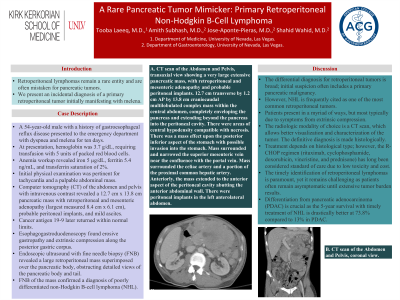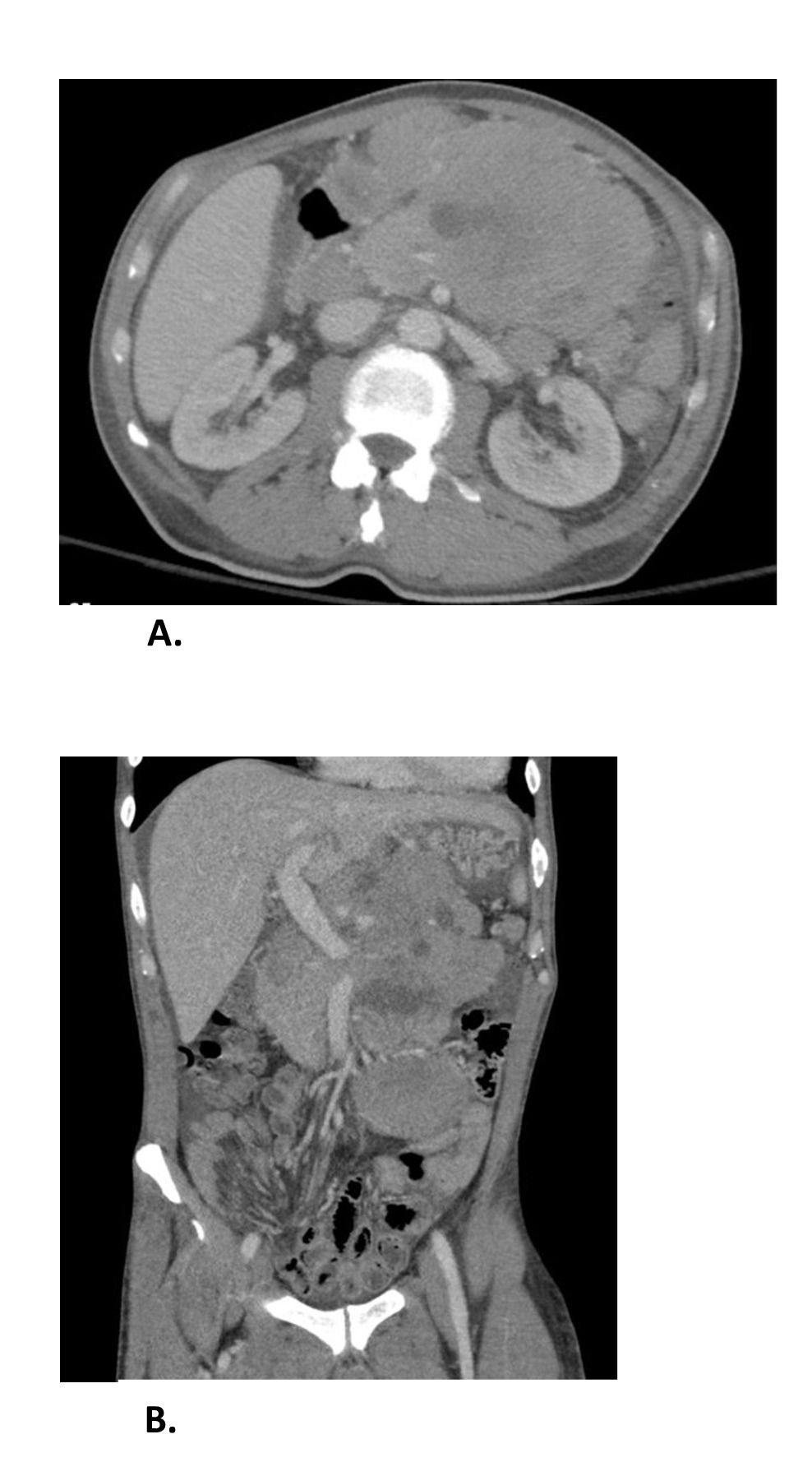Monday Poster Session
Category: Biliary/Pancreas
P1836 - A Rare Pancreatic Tumor Mimicker: Primary Retroperitoneal Non-Hodgkin B-Cell Lymphoma
Monday, October 28, 2024
10:30 AM - 4:00 PM ET
Location: Exhibit Hall E

Has Audio
- TL
Tooba Laeeq, MD
University of Nevada
Las Vegas, NV
Presenting Author(s)
Tooba Laeeq, MD, Amith Subhash, MD, Jose Aponte-Pieras, MD, Shahid Wahid, MD
Kirk Kerkorian School of Medicine at the University of Nevada, Las Vegas, NV
Introduction: Retroperitoneal lymphomas remain a rare entity and are often mistaken for pancreatic tumors. We present an incidental diagnosis of a primary retroperitoneal tumor initially manifesting with melena.
Case Description/Methods: A 54-year-old male with a history of gastroesophageal reflux disease presented to the emergency department with dyspnea and melena for ten days. At presentation, hemoglobin was 3.7 g/dL, requiring transfusion with 5 units of packed red blood cells. Anemia workup revealed: iron 5 µg/dL, ferritin 5.4 ng/mL, and transferrin saturation of 2%. Initial physical examination was pertinent for tachycardia and a palpable abdominal mass. Computer tomography (CT) of the abdomen and pelvis with intravenous contrast revealed a 12.7 cm x 13.8 cm pancreatic mass with retroperitoneal and mesenteric adenopathy (largest measured 8.4 cm x 6.1 cm), probable peritoneal implants, and mild ascites. Cancer antigen 19-9 later returned within normal limits. Esophagogastroduodenoscopy found erosive gastropathy and extrinsic compression along the posterior gastric corpus. Endoscopic ultrasound with fine needle biopsy (FNB) revealed a large retroperitoneal mass superimposed over the pancreatic body, obstructing detailed views of the pancreatic body and tail. FNB of the mass confirmed a diagnosis of poorly differentiated non-Hodgkin B-cell lymphoma (NHL).
Discussion: The differential diagnosis for retroperitoneal tumors is broad; initial suspicion often includes a primary pancreatic malignancy. However, NHL is frequently cited as one of the most common retroperitoneal tumors. Patients present in a myriad of ways, but most typically due to symptoms from extrinsic compression. The radiologic modality of choice is a CT scan, allowing better visualization and characterization of the tumor with the definitive diagnosis made histologically. Treatment depends on histological type; however, the R-CHOP regimen (rituximab, cyclophosphamide, doxorubicin, vincristine, and prednisone) has long been considered standard of care due to low toxicity and cost. The timely identification of retroperitoneal lymphomas is paramount, yet it remains challenging as patients often remain asymptomatic until extensive tumor burden results. Differentiation from pancreatic adenocarcinoma (PDAC) is crucial as the 5-year survival with timely treatment of NHL is drastically better at 73.8% compared to 13% in PDAC.

Disclosures:
Tooba Laeeq, MD, Amith Subhash, MD, Jose Aponte-Pieras, MD, Shahid Wahid, MD. P1836 - A Rare Pancreatic Tumor Mimicker: Primary Retroperitoneal Non-Hodgkin B-Cell Lymphoma, ACG 2024 Annual Scientific Meeting Abstracts. Philadelphia, PA: American College of Gastroenterology.
Kirk Kerkorian School of Medicine at the University of Nevada, Las Vegas, NV
Introduction: Retroperitoneal lymphomas remain a rare entity and are often mistaken for pancreatic tumors. We present an incidental diagnosis of a primary retroperitoneal tumor initially manifesting with melena.
Case Description/Methods: A 54-year-old male with a history of gastroesophageal reflux disease presented to the emergency department with dyspnea and melena for ten days. At presentation, hemoglobin was 3.7 g/dL, requiring transfusion with 5 units of packed red blood cells. Anemia workup revealed: iron 5 µg/dL, ferritin 5.4 ng/mL, and transferrin saturation of 2%. Initial physical examination was pertinent for tachycardia and a palpable abdominal mass. Computer tomography (CT) of the abdomen and pelvis with intravenous contrast revealed a 12.7 cm x 13.8 cm pancreatic mass with retroperitoneal and mesenteric adenopathy (largest measured 8.4 cm x 6.1 cm), probable peritoneal implants, and mild ascites. Cancer antigen 19-9 later returned within normal limits. Esophagogastroduodenoscopy found erosive gastropathy and extrinsic compression along the posterior gastric corpus. Endoscopic ultrasound with fine needle biopsy (FNB) revealed a large retroperitoneal mass superimposed over the pancreatic body, obstructing detailed views of the pancreatic body and tail. FNB of the mass confirmed a diagnosis of poorly differentiated non-Hodgkin B-cell lymphoma (NHL).
Discussion: The differential diagnosis for retroperitoneal tumors is broad; initial suspicion often includes a primary pancreatic malignancy. However, NHL is frequently cited as one of the most common retroperitoneal tumors. Patients present in a myriad of ways, but most typically due to symptoms from extrinsic compression. The radiologic modality of choice is a CT scan, allowing better visualization and characterization of the tumor with the definitive diagnosis made histologically. Treatment depends on histological type; however, the R-CHOP regimen (rituximab, cyclophosphamide, doxorubicin, vincristine, and prednisone) has long been considered standard of care due to low toxicity and cost. The timely identification of retroperitoneal lymphomas is paramount, yet it remains challenging as patients often remain asymptomatic until extensive tumor burden results. Differentiation from pancreatic adenocarcinoma (PDAC) is crucial as the 5-year survival with timely treatment of NHL is drastically better at 73.8% compared to 13% in PDAC.

Figure: A. CT scan of the Abdomen and Pelvis, transaxial view showing a very large extensive pancreatic mass, with retroperitoneal and mesenteric adenopathy and probable peritoneal implants. 12.7 cm transverse by 1.2 cm AP by 13.8 cm craniocaudal multilobulated
complex mass within the central abdomen completely enveloping the pancreas and extending beyond the
pancreas into the peritoneal cavity. There were areas of central hypodensity compatible with
necrosis. There was a mass effect upon the posterior inferior aspect of the stomach with possible
invasion into the stomach. Mass surrounded and narrowed the superior mesenteric vein near the
confluence with the portal vein. Mass surrounded the celiac artery and a portion of the proximal
common hepatic artery. Anteriorly, the mass extended to the anterior aspect of the peritoneal cavity
abutting the anterior abdominal wall. There were peritoneal implants in the left anterolateral
abdomen.
B. CT scan of the Abdomen and Pelvis, coronal view.
complex mass within the central abdomen completely enveloping the pancreas and extending beyond the
pancreas into the peritoneal cavity. There were areas of central hypodensity compatible with
necrosis. There was a mass effect upon the posterior inferior aspect of the stomach with possible
invasion into the stomach. Mass surrounded and narrowed the superior mesenteric vein near the
confluence with the portal vein. Mass surrounded the celiac artery and a portion of the proximal
common hepatic artery. Anteriorly, the mass extended to the anterior aspect of the peritoneal cavity
abutting the anterior abdominal wall. There were peritoneal implants in the left anterolateral
abdomen.
B. CT scan of the Abdomen and Pelvis, coronal view.
Disclosures:
Tooba Laeeq indicated no relevant financial relationships.
Amith Subhash indicated no relevant financial relationships.
Jose Aponte-Pieras indicated no relevant financial relationships.
Shahid Wahid indicated no relevant financial relationships.
Tooba Laeeq, MD, Amith Subhash, MD, Jose Aponte-Pieras, MD, Shahid Wahid, MD. P1836 - A Rare Pancreatic Tumor Mimicker: Primary Retroperitoneal Non-Hodgkin B-Cell Lymphoma, ACG 2024 Annual Scientific Meeting Abstracts. Philadelphia, PA: American College of Gastroenterology.
